The latest draft of the Coronavirus stimulus and relief legislation, the American Rescue Plan Act of 2021, would award $350 billion to state, territory, tribal and local governments using a variety of allocation formulas that produce some incongruous results. On a per-capita basis, Florida, Georgia, Ohio, and Virginia are among the states that would come out on the short end of coronavirus relief allocations.
Of the $350 billion that would go to state and local governments, just under $200 billion is earmarked for the 50 states, the District of Columbia, and five overseas territories. Excluding those territories, the state aid averages $593 per resident, based on 2020 population estimates from the Census Bureau.
The allocation formula includes a flat $500 million for each state and a special $750 million allocation to the District of Columbia to compensate for the fact that it did not receive a state allocation under the CARES Act. But the bulk of the funding is allocated according to the average number of unemployed people in each jurisdiction during the last three months of 2020.
Setting aside the District of Columbia, the allocation formula used by the legislation benefits low population states and those that had high unemployment rates at the end of last year, relative to other states. Among the states benefitting from this scheme are low population Vermont, which is slated to receive $1,050 per person, and California, which would expect to receive $667 per person, in part because the state ended 2020 with a 9 percent unemployment rate—well above the December national unemployment rate of 6.7 percent. It should be noted that because December 2020 unemployment statistics from the Bureau of Labor Statistics are still preliminary, allocations are still subject to change.
Vermont and California do not appear to be the neediest candidates for federal aid given their relatively strong tax revenue performance. For the calendar year 2020, revenues in Vermont exceeded prior-year tax revenues by 12.8 percent, according to a Reason Foundation analysis of monthly state revenues. The state’s economy benefited from an influx of residents escaping urban areas and it is less dependent on businesses hit hardest by the COVID-19 pandemic, such as restaurants and hotels.
In California in 2020, the state’s general fund revenues rose 4.2 percent year on year. Despite the pandemic driving high unemployment, lockdowns, and extensive business closures, the state’s revenues were helped by income tax receipts from its high-income technology and finance professionals who enjoyed stable employment and capital gains.
California did lose a lot of jobs, but most of them belonged to individuals with modest incomes. Due to the highly progressive nature of California’s income tax system, the state’s tax revenue gains from upper-income workers who continued to work during the pandemic far exceeded its losses from those who became unemployed.
By contrast, Florida stands to receive only $474 in state aid per resident from the House coronavirus aid bill, despite suffering a calendar-year tax revenue loss of 7.8 percent. Without a state income tax, Florida did not have an income stream to offset its declining tourism-related tax revenues. Three other large states that will also receive less than $500 per person of federal aid from the COVID-19 stimulus bill are Georgia ($438), Virginia ($442), and Ohio ($486). Unlike Florida, these three states saw small revenue gains for the calendar year.
Unemployment rates may seem to be a reasonable basis for state aid allocations, but when one gets into the details of state finance, they can prove to be less relevant. States certainly have higher unemployment insurance and health care costs due to the pandemic. California’s unemployment insurance payments increased from $5 billion in 2019 to at least $24 billion in 2020. But unemployment insurance is already partially covered by the federal government as well as taxes on employers. And states can borrow additional money from the federal government if these tax revenues are temporarily insufficient, as they were during the Great Recession and again last year. Unemployment also impacts Medicaid enrollment. Although Medicaid is typically a state’s largest expenditure, the federal government has already offset some of the added state costs arising from COVID-19 by increasing the share of each Medicaid claim it covers.
On a per-capita basis, the allocations to the 50 states in the House stimulus bill are dwarfed by those going to four US territories with small populations. American Samoa and the Northern Mariana Islands stand to receive over $8,000 per person from the House bill. Both territories have fewer than 60,000 residents but benefit from the fact that the aid bill allocates $450 million to each of the five territories regardless of their population. The rest of the territorial funding formula is based on population. Guam and the US Virgin Islands also stand to receive outsized per capita allocations, while Puerto Rico’s funding is on a par with some smaller states.
As we and others have reported, state revenue losses are proving to be far less than originally feared and are almost certain to be a small fraction of the $200 billion in federal support now included in the latest reconciliation measure.
State and Territorial Aid Per Capita in Budget Reconciliation

